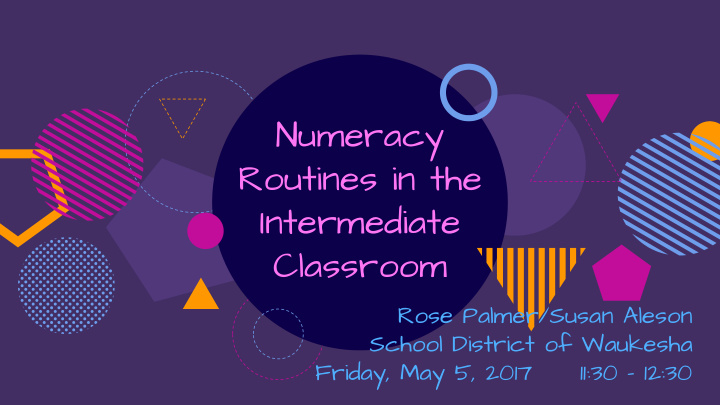



Numeracy Routines in the Intermediate Classroom Rose Palmer/Susan Aleson School District of Waukesha Friday, May 5, 2017 11:30 - 12:30
Session Outcomes Participants will ~ understand the purpose of doing regular numeracy routines learn different types of numeracy routines engage in samples of numeracy routines
What is a Numeracy Routine? An oral warm-up activity of 3-5 minutes Done on a regular basis Focused on a content standard Has students engaged with learning and critical thinking Used in place of traditional warm-ups or reviewing of homework
Why Routines? Make the design and flow of the learning experience more predictable Help to build critical math thinking habits Provide for a wide range of learners to access and use math practices Support reasoning and explaining thinking Support mental math calculations / fact fluency Support making sense of numbers Support students learning from each other
Number Sense Routines Visual Routines Counting Routines Numbers and Relationships Number Talks Problem Solving
Visual Routines Subitizing/Quick Images Using Dot Cards (Regular and Irregular) Twenty Frames Rekenreks (bead rack) Arrays Visual Patterns
Dot Cards Regular Irregular
Twenty Frames
Rekenreks
Arrays
Visual Patterns Website How many squares in step 10? 100? How many toothpicks in step 10? 100?
Counting Routines Count Around Choral Counting Bizz-Buzz
Count Around All students participate. Everyone needs to listen to each other and count in their heads. Provide wait-time for students. Students develop fluency with place value and multiplication patterns. Teachers can record the numbers on the board to help with the noticing of patterns.
Count Around Variations Start at any number and count forwards or backwards (by 5s, 10s, 25s, 100s, powers of 10, etc.) ◌ Target number to reach ◌ Ask “What number will Jane say?” or “Will we reach 700 by the time we go around once?” Start at a multiple of a number and count forwards/ backwards (start at 120 and count backwards by 4s) Focus on fractions and decimals (count forwards/ backwards by halves starting at 13½ or by tenths starting at 24.0)
Count Around Variations Non-Incremental Counting ◌ 128, 64, 32, 16, 8, 4, 2, 1, ½, ¼, ⅛ , … ◌ 1, 3, 6, 10, 15, 21, 28, 36, 45 Each student picks a coin and keeps it visible. Count around adding the value of the coin. . Use coins appropriate to your grade level. 1, 26, 31, 41, 42, 67...
Choral Counting Counting aloud as a whole class Use when learning a new counting sequence Can start with visual supports (ie. hundreds chart, number line) and then gradually remove Variation: Divide class into sections to count by (ie., 1/2s, 1/4s, 1/8s, etc.) and then direct which group is counting
Bizz Buzz Determine multiples to focus on (ie. 3 and 5) Students count around the circle counting by 1 s. When the count is a multiple of 3, instead of saying the number, you say “Bizz”. When the count is a multiple of 5, instead of saying the number, you say “Buzz”. When the count is a multiple of 3 and 5, instead of saying the number, you say “Bizz Buzz”.
Numbers and Relationships Target Number Guess My Number Which one’s not like the others? Operation Estimation Number Talks True False? Would you rather?
Target Number Provide students with a target number. Students think of as many ways as possible to represent the number. Share out their thinking while teacher records.
Guess My Number Give or select three clues about the number. ◌ Between 300 and 550 ◌ An even number ◌ Multiple of 4 Students think through possible numbers for a moment Share with a partner Share with whole group Variation: have students create clues to share
Which one’s not like the others? quart liter 42 36 gallon yard 77 28 Which one doesn’t belong? Website
Operation Estimation: Estimation 180 Website
Operation Estimation: Where Am I? On a number line, indicate where your selected number is located. Students give possible answers. Teacher places their answers on the number line to help zero in on the number. 5½ 3½ ? Variation: Give students numbers to place on line..
Operation Estimation: Could be or Crazy? ● Teacher makes a statement. ● Students decide if the statement “Could be” true, or is “crazy” and explain their reasoning. ● Examples: ○ If all the students in our school held hands outside we would reach all the way around our building. ○ This container can hold 100 cm cubes. ○ Mrs. Palmer ate 3/5 of a pizza.
Number Talks Pre-planned problem or string of problems that lead students to an understanding. Example: 3 x 7, 30 x 7, 30 x 70, 0.3 x 7, 0.3 x 0.7 Resources:
True/False This routine helps students to look at equality. Provide students with an equation to analyze. Students determine if it is true or false and defend their position. 48 + 63 - 62 = 47 3 x 7 = 7 + 7 + 7
Would you rather? Website
Problem Solving Keep it short for an opening Can use CGI Problem types Avoid students racing to a solution Encourage working together Facilitate productive discourse Use a “warm-up” problem for the context of the main lesson’s problem
Problem Solving The punch for the class party has orange juice, pineapple juice, and ginger ale. There is twice as much orange juice as there is pineapple juice, and 3 times more ginger ale than pineapple juice. How many ounces of each is needed if making 1½ gallon (192 ounces) of punch?
Questions?
Resources ● Which one doesn’t belong? Website ● Estimation 180 Website ● Would you rather? Website ● Visual Patterns Website
Thank you! Contact information: Rose Palmer rpalmer@waukesha.k12.wi.us @RBrunnerPalmer Susan Aleson saleson@waukesha.k12.wi.us
Recommend
More recommend